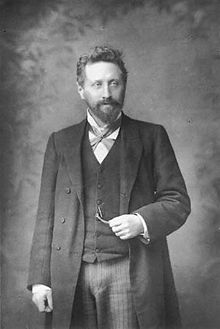William Edward Ayrton
William Edward Ayrton (born September 14, 1847 in London , † November 8, 1908 ) was a British physicist .
Live and act
Ayrton was the son of the lawyer Edward Nugent Ayrton (1815-1873), his uncle was the politician Acton Smee Ayrton (1816-1886).
education
From 1859 Ayrton attended University College School and was able to successfully switch to University College London in 1864 . There he was soon able to distinguish himself and was awarded the Andrew Scholarship in Mathematics in 1865 and 1866 . During his studies he became engaged to his cousin Matilda (1846-1883). For a short time Ayrton went to the University of Glasgow to study with Lord Kelvin . Through his lecturers George Carey Foster and Thomas Archer Hirst , Ayrton got a job with the colonial administration of British India .
Working in India
On September 1, 1868, he began there - in collaboration with the German engineer Carl Louis Schwendler (1838–1882) - to modernize the telegraph connections between British and India. While on vacation in his home country, he married his cousin Matilda on December 21, 1871 in St. Matthew's Parish Church ( Bayswater ). With her they had a daughter, Edith (1874–1945), who later became a feminist and wife of the writer Israel Zangwill .
In 1872 Ayrton returned to British India without his wife, quit his job, and then returned to England for good in the autumn of the same year. Through Lord Kelvin and the physicist William John Macquorn Rankine , he was brought to Tokyo in the fall of 1873 with a five-year contract as a professor of physics and telegraphy at the Imperial Engineering School (today the Faculty of Engineering at the University of Tokyo ) .
Working as a lecturer and professor in England
In the fall of 1878 Ayrton returned to England and in the spring of 1879 he was appointed as a lecturer at Finsbury Technical College . In 1881 he was elected a member of the Royal Society . His wife developed TB during this time and died of it in July 1883.
On May 6, 1885, Ayrton married Herta Marks , a daughter of the jeweler Levi Marks, for the second time . With her he had a daughter, Barbara (1886-1950), the future politician and wife of the writer Gerald Gould (1885-1936).
At the beginning of autumn 1885 Ayrton was appointed lecturer at the City and Guilds of London Institute . There, too, he worked with his friend and colleague John Perry (1850-1920); u. a. they occupied themselves with the construction of measuring instruments , with the improvement of dynamo machines , with electric railways and other electrotechnical fields.
Between 1890 and 1892 Ayrton presided over as President of the Physical Society of London . In 1904 he served as Dean of the City and Guilds of London Institute . About his daughter Edith he made a. a. also made the acquaintance of Emmeline Pankhurst and supported them in 1903 in founding the Women's Social and Political Union . In June 1908 he was at their big rally and demonstration in Hyde Park .
William Edward Ayrton died on November 8, 1908 at his home in Norfolk Square (Hyde Park). The funeral took place on November 12, 1908 without a church ceremony in Brompton Cemetery , only his son-in-law Israel Zangwill gave a funeral speech.
Honors
- 1901 Royal Medal of the Royal Society
Works
-
Practical Electricity . London 1881, online at archive.org .
- German: Handbook of practical electricity . Costenoble, Jena 1889.
literature
- William Edward Ayrton. In: Oxford Dictionary of National biography , Vol. 3 . OUP, Oxford 2004, ISBN 0-19-861353-9 , pp. 48-51.
Web links
- Entry in the archives of the Royal Society
| personal data | |
|---|---|
| SURNAME | Ayrton, William Edward |
| BRIEF DESCRIPTION | British physicist |
| DATE OF BIRTH | September 14, 1847 |
| PLACE OF BIRTH | London |
| DATE OF DEATH | November 8, 1908 |
| Place of death | London |
